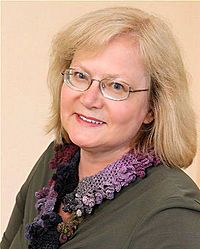Daina Taimiņa facts for kids
Daina Taimiņa (born August 19, 1954) is a Latvian mathematician. She is well-known for inventing a unique way to show hyperbolic geometry using crochet models. She used to be a professor of mathematics at Cornell University.
Contents
Education and Career
Her Studies in Latvia
Daina Taimiņa completed all her schooling in Riga, Latvia. In 1977, she graduated with high honors from the University of Latvia. She then continued her studies in Theoretical Computer Science. In 1990, she earned her first doctoral degree. At that time, she had to defend her thesis in Minsk because of rules in the Soviet system.
After Latvia became independent in 1991, Daina Taimiņa received a higher doctoral degree in mathematics from the University of Latvia. She taught there for 20 years.
Teaching at Cornell
In December 1996, Daina Taimiņa joined the Math Department at Cornell University. She combines her love for mathematics and crocheting. She is part of a group called the Mathemalchemy Team. This team includes 24 mathematicians and artists.
Hyperbolic Crochet
What is Hyperbolic Geometry?
Hyperbolic geometry is a special type of geometry. It is different from the flat geometry we usually learn in school. Imagine a saddle shape or a ruffled lettuce leaf; these are examples of hyperbolic surfaces. It's a bit tricky to understand without seeing it.
How the Idea Started
In 1997, Daina Taimiņa went to a geometry workshop at Cornell University. There, she saw a fragile paper model of a hyperbolic plane. It was made by Professor David Henderson. She wanted to make stronger models that would last longer.
She decided to use crochet. On the very first night after seeing the paper model, she started trying out different crochet patterns. She imagined hyperbolic planes as something that grows very quickly, like an explosion.
Making Models for Students
The next fall, Taimiņa was going to teach a geometry class at Cornell. She wanted to find the best way to help her students understand. So, during the summer, she spent her days by the pool. While watching her daughters swim, she crocheted a whole set of hyperbolic plane models for her class. These were the first ever made from yarn.
Impact on Learning
Her students found the models very helpful. They said they "liked the hands-on way of exploring hyperbolic geometry." It helped them understand this complex math better. This was exactly what Taimiņa felt was missing when she first learned about hyperbolic planes. Her models have become a popular way to explain hyperbolic space in geometry.
Daina Taimiņa gave a TedxRiga talk. She shared how she needed a visual way to understand hyperbolic planes. This led her to invent her crocheted geometry models. In her talk, she also explained basic hyperbolic geometry using her models. She also mentioned some people initially thought crocheting was not suitable for mathematics.
William Thurston, who designed the original paper model, wrote about Taimiņa's models. He said they were "deceptively interesting." He believed they offered a hands-on way to understand this complex part of mathematics.
Workshops and Books
Taimiņa has led many workshops at Cornell University. She taught college geometry instructors with Professor David Henderson, who later became her husband.
Her crocheted math models appeared in three geometry textbooks they wrote together. The most popular one is Experiencing Geometry: Euclidean and non-Euclidean with History. In 2020, Taimiņa made the 4th edition of this book available for free online.
Exhibitions and Recognition
An article about Taimiņa's invention appeared in New Scientist. The Institute For Figuring (IFF) in Los Angeles saw it. They invited her to talk about hyperbolic space and its links to nature. Her talks sparked a lot of interest in this new way of exploring geometry. It made this advanced topic understandable to many people, including artists and movie producers.
At first, she made purely mathematical models. But soon, Daina Taimiņa became known as a fiber artist and public speaker. Her work was first shown as art in June 2005. This was at an exhibition called "Not The Knitting You Know" in Washington, D.C.. Since then, her art has been shown in galleries in many countries. Her work is now in collections at the Smithsonian Museum and the Cooper–Hewitt, National Design Museum.
Her work has also been featured in many media outlets. Discover magazine and The Times wrote about her "Knit Theory." They explained how a hyperbolic plane can be crocheted. You do this by increasing the number of stitches:
For example, adding an extra stitch in the second line for every five stitches in the first. And for every five stitches in the second line, adding an extra one in the third. The number of stitches increases at an exponential rate. As the lines are longer, but joined together, the material quickly starts to fold in interesting ways.
The Institute For Figuring later published a guide based on Taimiņa's work. It was called "A Field Guide to Hyperbolic Space." In 2005, the IFF used Taimiņa's ideas to help make mathematics more popular. They created an exhibition that was featured in the Los Angeles Times.
Taimiņa's method of exploring hyperbolic space through crochet has been very successful. It has even helped people overcome math phobia. This approach was used by Margaret Wertheim in the IFF-curated Hyperbolic Crochet Coral Reef project.
Books
Taimiņa's book "Crocheting Adventures with Hyperbolic Planes" (published in 2009) won the 2009 Bookseller/Diagram Prize for Oddest Title of the Year. It also won the 2012 Euler Book Prize from the Mathematical Association of America.
She also helped write David W. Henderson's book Differential Geometry: A Geometric Introduction (1998). With Henderson, she wrote Experiencing Geometry: Euclidean and Non-Euclidean with History (2005).
See also
 In Spanish: Daina Taimina para niños
In Spanish: Daina Taimina para niños
- Mathematics and fiber arts


